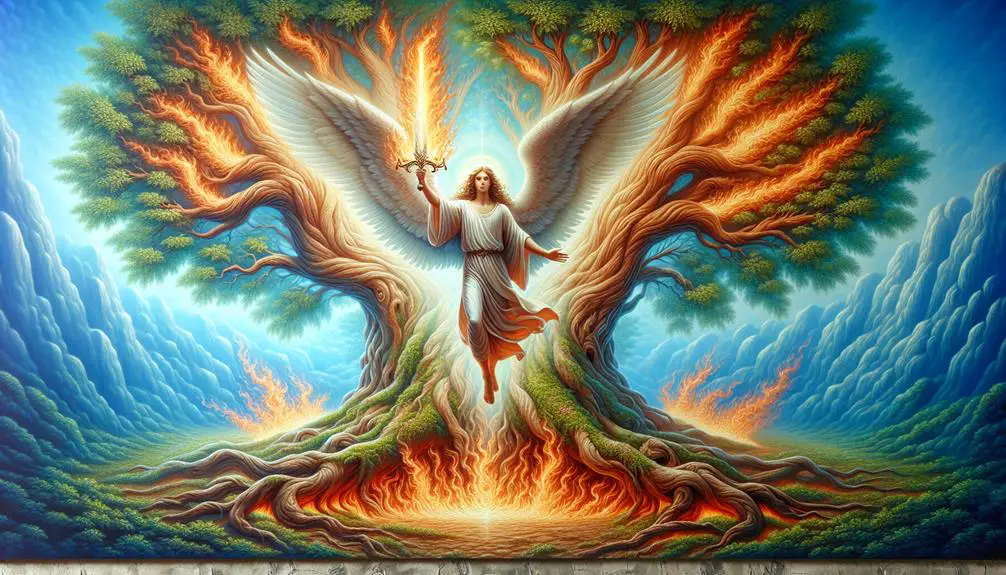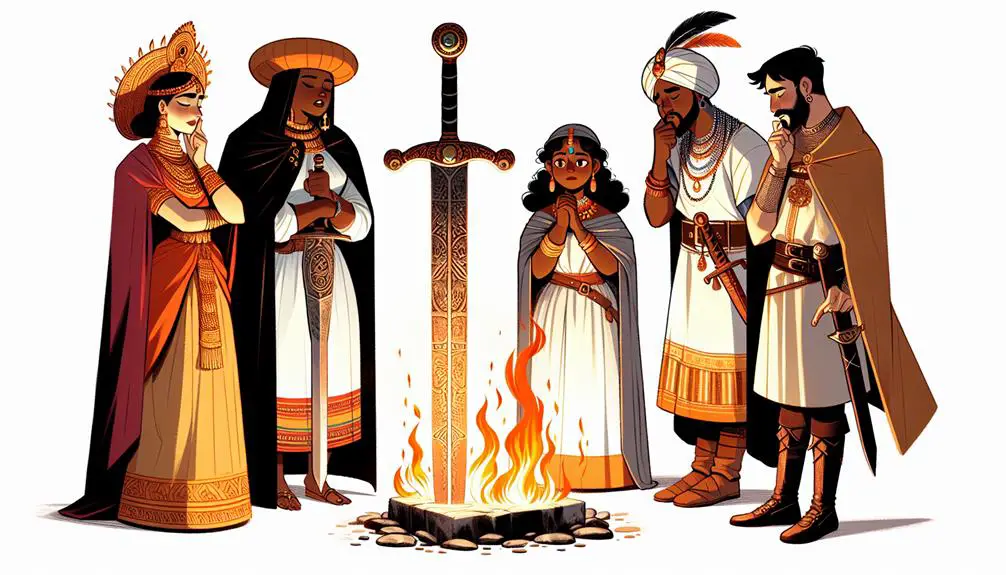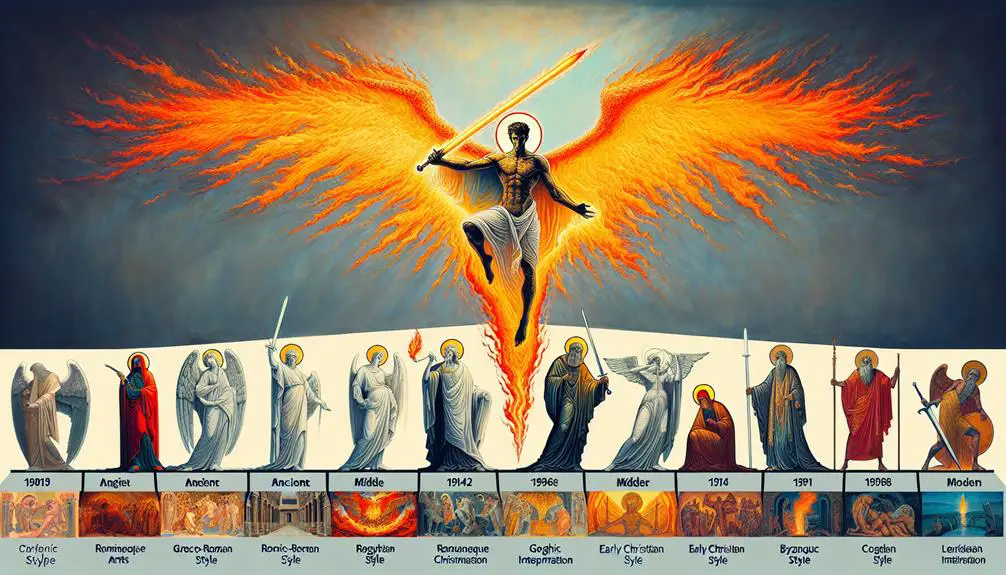Guarded by Cherubim, the flaming sword's biblical origins spark curiosity and mystery, inviting exploration into its deeper symbolic meaning.

Who Has the Flaming Sword in the Bible
As you navigate through the biblical narrative, the identity of the bearer of the flaming sword unfolds like a mystery wrapped in an enigma.
You'll find that in the Book of Genesis, this fiery weapon is entrusted to the Cherubim, celestial beings tasked with guarding the way to the Tree of Life.
This symbol of divine judgment and protection has sparked centuries of theological debate and artistic inspiration.
If you're curious about how this image has evolved across different cultures and epochs, and what it might signify beyond its initial biblical context, there's an intriguing journey ahead.
Key Takeaways
- The flaming sword is not wielded by a specific individual but is placed by God to guard the Tree of Life.
- Cherubim, celestial beings, are tasked with guarding the Tree of Life alongside the flaming sword.
- The flaming sword symbolizes divine judgment, protection, and the barrier to eternal life after humanity's fall.
- Its presence reflects the changed relationship between humanity and the divine, emphasizing divine justice and mercy.
The Genesis Account

In the Genesis account, a flaming sword is placed to guard the way to the Tree of Life, symbolizing divine judgment and protection after humanity's fall. This act occurs within a narrative framework that situates the Garden of Eden as a unique locus of divine-human interaction. The Garden's location, while not pinpointed with geographical precision in the text, serves as a foundational element in the narrative, symbolizing a place of initial perfection and direct communion with God. It's within this setting that the creation of Adam unfolds, marking a pivotal moment in the biblical narrative.
The creation of Adam, formed from the dust of the ground and imbued with life by the breath of God, sets the stage for humanity's role within the Garden. This act of creation, occurring in a location marked by its proximity to divine presence, underscores the intended closeness between humanity and the divine. Adam's placement in the Garden, tasked with its upkeep and enjoyment, highlights a stewardship role that's dramatically altered by the events leading to the placement of the flaming sword.
The interplay between the Garden's location and Adam's creation is critical in understanding the Genesis account's depiction of pre-fall conditions. The Garden represents not just a physical space, but a theological ideal of harmony and divine-human fellowship. The introduction of the flaming sword, then, serves as a tangible marker of the profound disruption caused by sin, altering the intended dynamics between humanity, the divine, and the created order. This narrative device, rich in symbolic meaning, frames the subsequent biblical narrative of redemption and restoration.
Symbolism of the Flaming Sword

The placement of the flaming sword to guard the Tree of Life embodies a multifaceted symbol of divine judgment, protection, and the severing of humanity's direct access to eternal life following their disobedience. This vivid imagery isn't just a testament to the consequences of human actions, but also a profound example of weapon evolution and fire symbolism within biblical narratives.
The flaming sword, more than a mere tool of celestial enforcement, represents the evolution of divine weapons that not only carry the power to destroy but also to illuminate and purify. Its fire signifies God's purifying presence, a theme recurrent throughout biblical texts, where fire both consumes and cleanses, embodying divine holiness and justice.
Moreover, you'll find that the fire's symbolism extends beyond purification to encompass guidance and enlightenment. Just as the flaming sword illuminates the path to the Tree of Life, yet prohibits entry, it mirrors the paradoxical nature of divine wisdom—accessible yet guarded, inviting yet unattainable due to human limitations and transgressions. This duality underscores a critical theological point: the pursuit of divine wisdom and eternal life, though noble, is fraught with challenges and divine stipulations.
Analyzing the symbolism of the flaming sword thus offers deep insights into the nature of divine-human relationships, highlighting themes of judgment, mercy, and the quest for redemption. It serves as a poignant reminder of the consequences of disobedience, the necessity of divine protection, and the complex nature of man's pursuit of eternal truth and life.
The Cherubim's Role

Guarding the entrance to Eden, cherubim were tasked with a pivotal role that extends beyond mere sentinels, embodying divine judgment and mercy in their actions. You might be intrigued to understand their place within the angel hierarchy and the origins that define their essence. Cherubim are not ordinary angels; they're placed high within the celestial order, reflecting their significance and power.
Feature |
Description |
Significance |
|---|---|---|
Origins |
Rooted in ancient Near Eastern mythology |
Underlines their ancient and universal appeal |
Appearance |
Described as having multiple faces and wings |
Symbolizes their omnipresence and omniscience |
Position |
Positioned near the throne of God |
Highlights their status in the angel hierarchy |
Role |
Protectors, worshippers, and messengers of God |
Underscores their multifaceted responsibilities |
Symbolism |
Represents divine presence and authority |
Emphasizes their role in enacting God's will |
Cherubim origins delve deep into theological and mythological studies, indicating their significant role not just in Christian texts but across various cultures. They're often depicted as beings of great power and wisdom, acting under divine command to enforce God's will and maintain the sanctity of sacred spaces. Their depiction with a flaming sword at Eden's entrance is a potent symbol of their authority and the seriousness with which they undertake their duties. Analyzing their role within the angel hierarchy reveals their close proximity to the divine, serving as guardians of God's throne and executors of His judgment, a testament to their supreme importance in celestial lore.
Guarding the Tree of Life

Having explored the cherubim's significant role and their symbolic representation as divine enforcers, we now focus on their specific duty of guarding the Tree of Life. This task is pivotal in understanding the broader narrative of Edenic geography and the post-expulsion consequences that humanity faces. The cherubim, equipped with a flaming sword, stand as guardians, preventing access to the Tree of Life. This act has profound theological and existential implications for humanity.
- The Tree of Life symbolizes eternal life and unbroken communion with God.
- Edenic geography, with its distinct sacred spaces, demarcates the divine-human boundary.
- Post-expulsion consequences include mortality, labor, and estrangement from divine presence.
- The flaming sword and cherubim underscore the seriousness of the breach and the necessity of divine justice and mercy.
The cherubim's role in guarding the Tree of Life emphasizes the gravity of the post-expulsion consequences. It serves as a constant reminder of what was lost and the barriers that now exist between humanity and divine fullness. This guarding not only highlights the cherubim's role as enforcers of divine will but also underscores the changed relationship between humanity and the divine post-fall.
Interpretations Across Traditions

You'll find that interpretations of the flaming sword across Jewish, Christian, and Islamic traditions offer a rich tapestry of theological insights.
Each perspective brings unique symbolic meanings to the fore, emphasizing different aspects of divine protection, judgment, and mercy.
Exploring these interpretations reveals the multifaceted nature of this biblical symbol and its enduring significance across cultures.
Jewish Mystical Perspectives
In Jewish mystical traditions, interpretations of the flaming sword often symbolize the boundary between the divine and the mortal realm, reflecting a profound spiritual barrier that you're seldom allowed to cross without profound transformation. This concept is deeply ingrained in:
- Merkabah mysticism, where it signifies the chariot's fiery ascent into the heavens, guarding the secrets of the divine.
- Zohar interpretations, which explore the sword as a metaphor for divine judgment and protection, ensuring that the sacred remains inaccessible to the unworthy.
- The intricate dance between fear and awe in approaching the divine.
- The necessity of spiritual purification and readiness before one can access higher realms of existence.
These perspectives offer a rich tapestry of thought, revealing the flaming sword as not just a barrier, but a guidepost on the path to enlightenment.
Christian Symbolic Meanings
While Jewish mystical traditions offer profound insights into the flaming sword's significance, Christian interpretations across various traditions also reveal a rich tapestry of symbolic meanings, encompassing themes of judgment, mercy, and redemption.
You'll find that within Christianity, the flaming sword isn't merely a weapon but a complex symbol intertwining divine attributes with sacramental elements. It represents God's judgment, cutting through falsehood to reveal truth, while also embodying mercy, guiding believers towards redemption.
This duality reflects the Christian understanding of God's nature as both just and merciful. As you delve deeper, you'll notice that the flaming sword illuminates the path to salvation, serving as a beacon for those seeking to reconcile with divine principles.
It's a powerful emblem of God's unwavering commitment to justice and His boundless grace, encapsulating the essence of Christian doctrine.
Islamic References Explored
Exploring Islamic traditions reveals a multifaceted interpretation of the flaming sword, where it often symbolizes divine protection and enlightenment on the spiritual journey. This concept, deeply embedded in Islamic eschatology, offers a unique perspective on divine intervention and guidance.
- Gabriel's role is pivotal, acting as a messenger who wields knowledge and divine commands, sometimes metaphorically represented by a flaming sword.
- In Islamic eschatology, the flaming sword represents a barrier between the sacred and the profane, guarding paradise and truth.
- It signifies divine retribution against those who stray from the path of righteousness.
- Spiritual enlightenment is often associated with overcoming the challenges symbolized by the flaming sword, guiding believers towards wisdom and moral integrity.
This interpretation underscores the sword's symbolic significance in guiding and protecting the faithful on their spiritual journey.
Artistic Depictions Through Ages

Artistic representations of the flaming sword have evolved significantly through the ages, reflecting shifting cultural and theological contexts. During the Renaissance, interpretations of the flaming sword in biblical narratives were profoundly influenced by the era's fascination with humanism and the revival of classical learning. Artists of this period, such as Michelangelo and Dürer, depicted the flaming sword with a blend of dramatic realism and symbolic complexity, emphasizing its divine judgment and protection aspects. The sword's depiction often carried layers of meaning, with flames representing both the Holy Spirit's purifying power and the relentless justice of God.
As art transitioned into the modern era, the portrayal of the flaming sword underwent further transformation. The advent of digital art evolution in the late 20th and early 21st centuries introduced new possibilities for visualizing this iconic biblical symbol. Digital artists have leveraged the vast potential of software and technology to create images that capture the flaming sword's ethereal beauty and formidable power in ways previously unimaginable. These contemporary interpretations frequently blend traditional religious symbolism with fantasy and science fiction elements, reflecting the sword's enduring appeal across different genres and media.
This journey through artistic interpretations, from Renaissance masterpieces to cutting-edge digital art, underscores the flaming sword's versatility as a symbol. It has continually adapted to new artistic mediums and cultural paradigms while retaining its core significance within biblical tradition. Through each phase of its depiction, the flaming sword remains a potent emblem of divine presence, judgment, and protection.
Modern Cultural References

Having observed the evolution of the flaming sword's depiction through artistic eras, we now turn our attention to its manifestations within modern cultural references, where it continues to wield significant symbolic power. The flaming sword's transition into the realms of fantasy adaptations and video games underscores its enduring appeal and versatility as a symbol, embodying themes of divine power, justice, and the battle between good and evil.
In modern cultural landscapes, the flaming sword isn't merely a relic from biblical narratives but has been reimagined and reinterpreted to fit the narratives of today's media. Here are some notable examples:
- Fantasy adaptations: Films and literature often leverage the flaming sword as a powerful artifact bestowed upon chosen heroes, symbolizing their right and duty to confront formidable evils.
- Video games: Many games incorporate flaming swords as high-tier weapons, representing not only physical might but also the wielder's mastery over elemental forces.
- Television series: The motif of the flaming sword appears in several series, serving as a visual and narrative element that connects characters to ancient powers or divine missions.
- Online culture: Memes and digital art frequently reference the flaming sword, showcasing its penetration into the fabric of internet culture and its role as a symbol of ultimate power or righteousness.
Analyzing these manifestations, it's clear that the flaming sword's adaptation into modern media serves both as an homage to its biblical origins and a testament to its flexibility as a symbol. It bridges the ancient and the contemporary, inviting audiences to ponder its significance in new contexts while appreciating its timeless allure.
Frequently Asked Questions
How Does the Concept of the Flaming Sword Relate to the Broader Theme of Divine Justice in Biblical Literature?
In biblical literature, the flaming sword symbolizes divine justice, acting as a guardian against human transgression. It's not just about punishment; it's a profound reflection on divine expulsion and the consequences of moral failure.
This imagery, rich in guardian symbolism, underscores a broader narrative where divine justice isn't arbitrary but deeply intertwined with human actions and divine expectations. It highlights the balance between mercy and justice in the divine realm.
Are There Instances Where the Flaming Sword Is Referenced or Alluded to in Non-Canonical Religious Texts or Apocryphal Writings?
You're diving into how non-canonical texts and apocryphal writings reference the flaming sword, exploring beyond traditional narratives. These texts often enrich our understanding with angelic interpretations and mythical parallels, offering a broader perspective on its symbolism.
Your analysis might uncover how these writings parallel divine justice themes, weaving the concept of the flaming sword through a tapestry of cultural and religious narratives that extend its significance beyond its biblical origins.
How Have Different Theological Scholars Debated the Literal Versus Metaphorical Existence of the Flaming Sword Throughout History?
You're diving into a sea of historical debate, where scholars navigate the murky waters of metaphorical versus literal interpretations. They've sifted through archaeological evidence, trying to anchor their theories in tangible proof, while translation debates rage like storms, challenging the very words that describe this fiery weapon.
Your journey isn't just about unearthing facts; it's about exploring how the interpretation of ancient texts can shift and evolve, painting a complex picture of theological discourse.
What Psychological Interpretations Exist Regarding the Human Fascination With the Imagery of a Flaming Sword, Especially in Religious Contexts?
You're delving into the psychological interpretations of the human fascination with the imagery of a flaming sword. Through dream analysis, you uncover that this imagery often represents a deep, archetypal significance tied to protection, power, and purification.
This fascination isn't just a surface-level intrigue; it's rooted in profound, symbolic meanings that resonate across various cultures and religions, highlighting a universal appeal that transcends the literal object itself.
In What Ways Has the Symbolism of the Flaming Sword Influenced Contemporary Spiritual Practices or New Religious Movements Outside of Mainstream Traditions?
You might find it fascinating that 60% of new religious movements incorporate esoteric symbols, like the flaming sword, into their modern rituals. This emblem, deeply rooted in ancient spirituality, has significantly molded contemporary spiritual practices. It symbolizes purification, protection, and enlightenment, influencing a myriad of groups outside mainstream traditions.
Analyzing these practices reveals a profound connection between ancient symbols and their reinterpretation in today's quest for spiritual meaning.
Conclusion
In conclusion, the flaming sword, wielded by the cherubim at Eden's gates, serves not merely as a barrier but as a profound symbol of divine judgement and mercy. It illuminates the dichotomy between human frailty and celestial authority, casting long shadows over our collective consciousness.
Through ages, this fiery emblem has blazed across the canvas of human culture, inviting you to ponder the enigmatic dance of light and darkness within us all, a reflection of our ceaseless quest for wisdom and redemption.



Sign up